Hunting With Henry’s Long Ranger in 6.5 Creedmoor
Russ Chastain 12.23.19
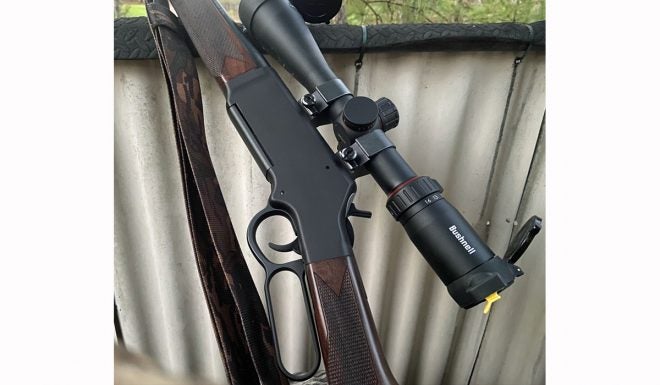
Some hunts take a long time to come together, and this is one of those hunts. The main factor in this particular hunt was not the site, the license, nor even the time off. It was the rifle.
The rifle happened to be a Henry ‘Long Ranger’ lever action — in 6.5 Creedmoor!
Yeah, that’s right.
I’d had a tough time matching ammo to rifle and getting a good tight group out of it, and had even ended up trying two different rifles. In the end, I took the Long Ranger on the hunt, but I was not at all sure I was going to hunt with it.
I’d topped the gun with good glass: a Bushnell Nitro 4x-16x 44mm scope with 30mm tube. I’d opted for my favorite reticle for hunting, the “plex” variety, which Bushnell calls “Multi-X SFP.”
You may be thinking this is a lot of scope for a lever gun, and you’d be right — but I have learned to love high-power scopes on rifles capable of long reach, as the 6.5 Creedmoor most certainly is. And the Long Ranger is not your typical lever gun, this is a heavy, serious rifle.
The rifle itself weighs 6.5 pounds with no sights or scope bases and an empty (removable box) magazine. The Nitro scope adds 1.4 pounds all by itself (without rings). So once the scope gets mounted and you add a sling and some groceries, you’re toting about ten pounds of deer-getter.
After arriving at the hunting property and getting camp squared away, I grabbed the Henry and some ammo and headed for the range. Out of the variety of ammo generously provided by Norma and Federal, I’d gotten the best accuracy from Norma’s 130-grain load and Federal Premium Nosler Accubond 140-grain (load P65CRDA1). I prefer heavier bullets and the 140s seemed to do a smidge better the last time I’d fired the rifle, so I decided to try the Federals.
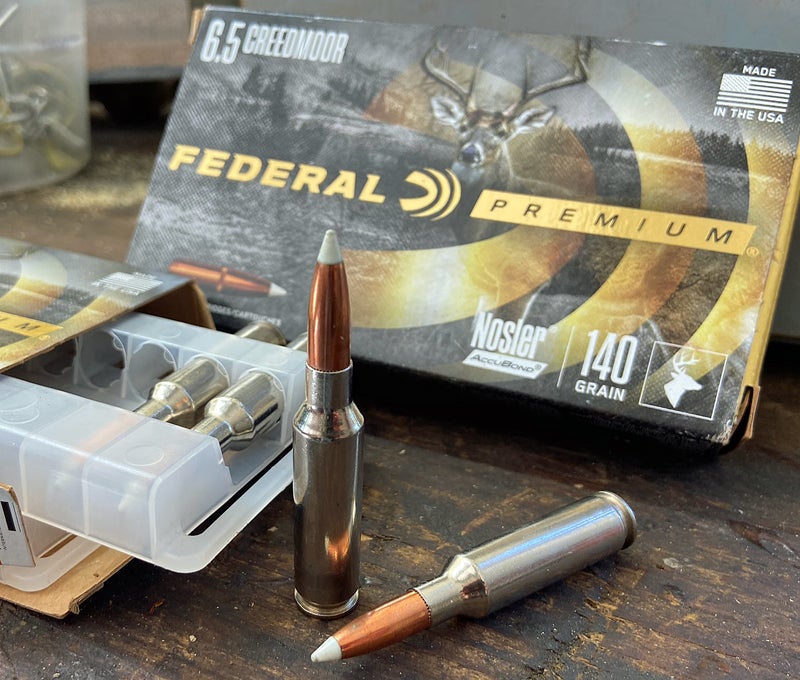
(Photo © Russ Chastain)
I fired at 100 and 200 yards, and in short, I was amazed. Gone were any accuracy woes; after firing two about 1-1/4″ apart at 100, I fired a pair at 200. And although I felt I’d pulled the second shot to the right, the two bullet holes were overlapping on the target! I adjusted the scope and fired another pair, which hit one inch apart at 200 yards. Wellsir, I’ll take half-MOA groups from a hunting rifle all day every day.
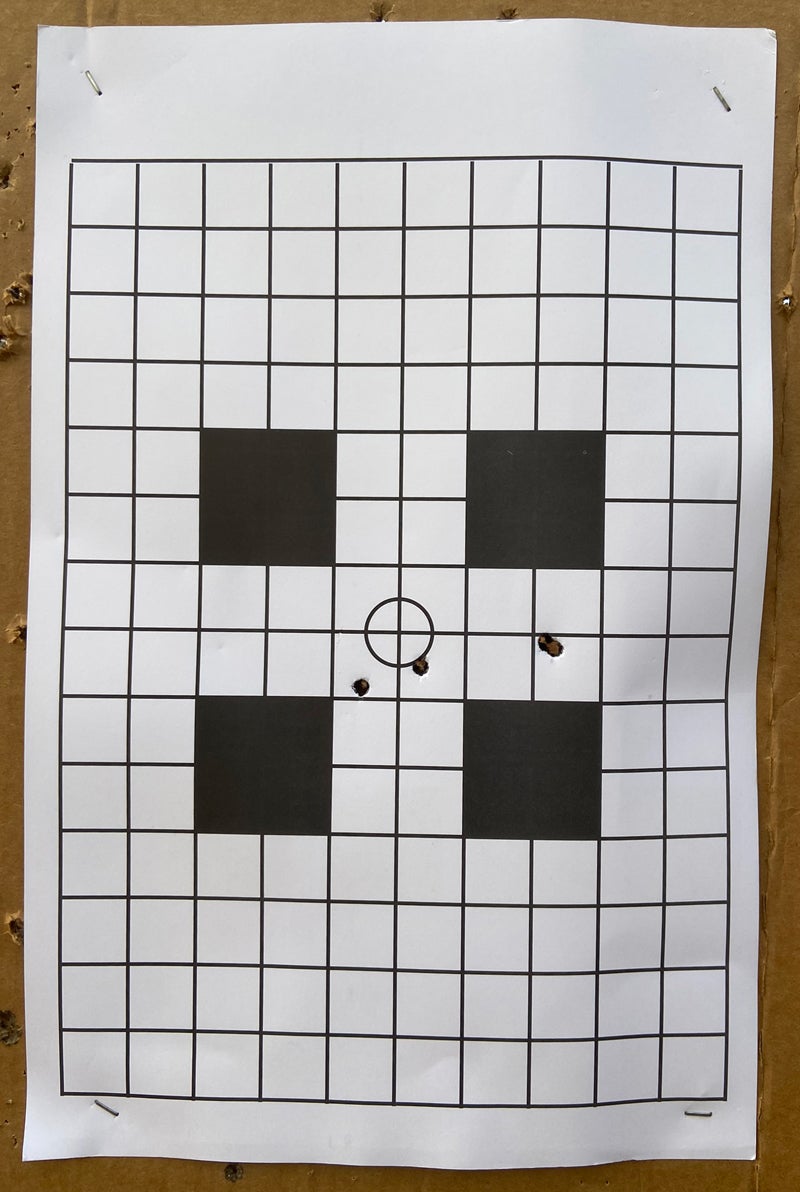
(Photo © Russ Chastain)
I can’t say why the rifle decided to behave after giving me so much grief, but I’m sure glad it did.
I was hunting for does on this trip. If a mature buck crossed my path, that was all well and good — but I have hungry friends and plenty of does, and it was time to reap some venison. The season was a couple of months old by now, though, and adult deer had largely become cagey. It was going to take some time to connect with a good meaty doe, and that was fine with me, because I can’t think of a better way to spend my time than deer hunting.
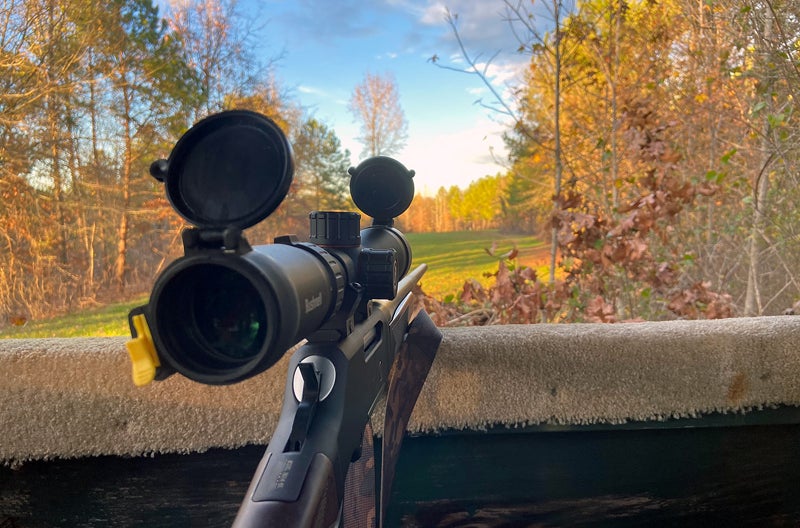
(Photo © Russ Chastain)
That Wednesday afternoon I saw a number of young bucks and fawns, but nothing I could positively identify as a shooter.
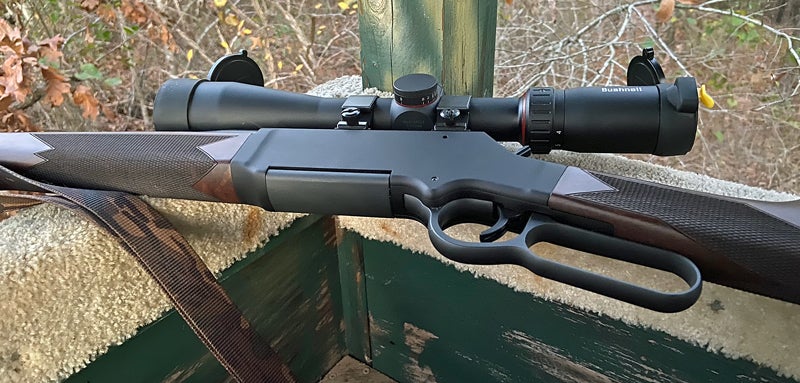
(Photo © Russ Chastain)
On Thursday I saw nothing in the morning and five fawns in the afternoon. Friday was filled with rain — about six inches’ worth — but I managed to spend some time in a deer stand with the Henry. We both got a bit moist, but the flip-up scope caps on the Bushnell scope did a great job of keeping the blowing rain from sullying the glass in between deer sightings.
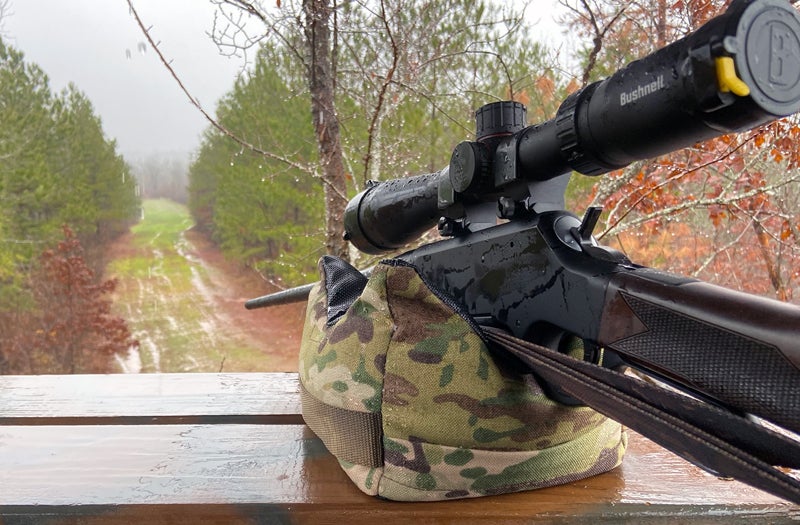
(Photo © Russ Chastain)
The soggy sit showed me 4 fawns, 4 bucks, and a doe, with the doe being the only shooter of the bunch. Unfortunately, she wouldn’t hold still long enough for a shot once I decided she was a shooter and cocked the rifle.
On Saturday morning, I sat for about 4.5 hours before something happened. Something good.
I’d been watching a couple of doe fawns feeding for more than an hour when a nervous deer emerged, not far away. It was a young doe, and by golly she was edgy.
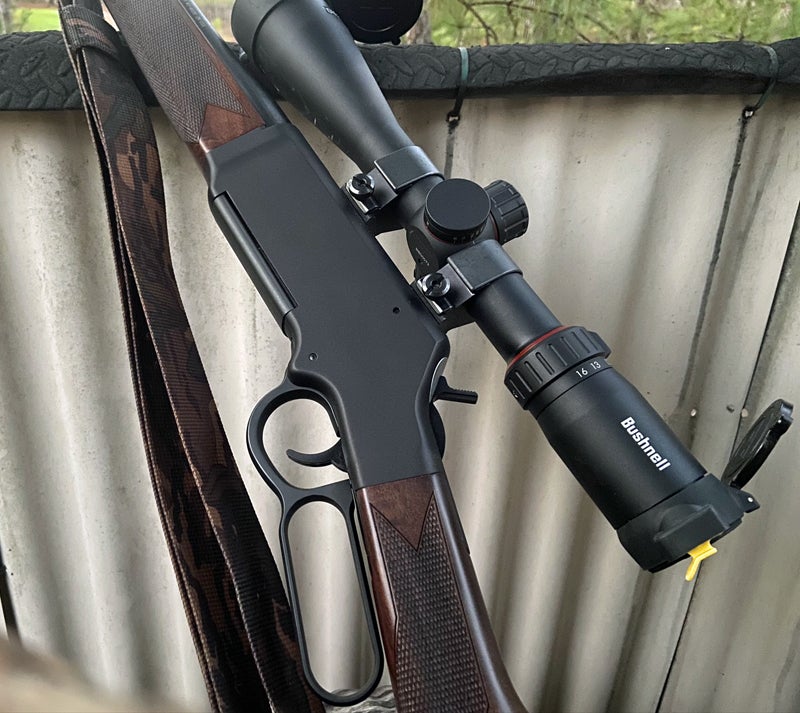
(Photo © Russ Chastain)
She was bobbing her head and stomping her hooves, just looking for something to be wrong. She moved slowly west about halfway through the plot, still going through those odd motions, and more deer emerged behind her. They were partially obscured by brush, but I managed to ID 3 more deer — two fawns and a nice big mature doe. Bingo!
All the deer were nervous, and when the first doe walked back to that group at the left edge of the clearing, I thought they were about to jump right back into the thick brush. She paused to lick a fawn, though, and the bigger doe stepped into the open and stood almost broadside, quartering slightly away, showing me her right side.
I laid the Bushnell’s crosshairs on the sweet spot and began to squeeze that Henry’s trigger. When it roared, the doe leapt left, sending dark clods of dirt into the air, and was gone. It had most certainly reacted to the shot as if hit — but it had not fallen. The rest of the deer followed and I was soon left trembling in the tree stand, shakily typing notes into my phone as I tried to catch my breath and recover from the adrenaline surge.
The range was 64 yards — hardly a long reach for the 6.5 Creedmoor. I felt good about the shot — but anytime a deer leaves my sight after the shot, I remain tense.
As I dutifully recorded my notes, I watched another large doe and two fawns cross 330 yards away, and was glad I’d already made my shot — because this stand didn’t offer a good enough rest to reach out that far.
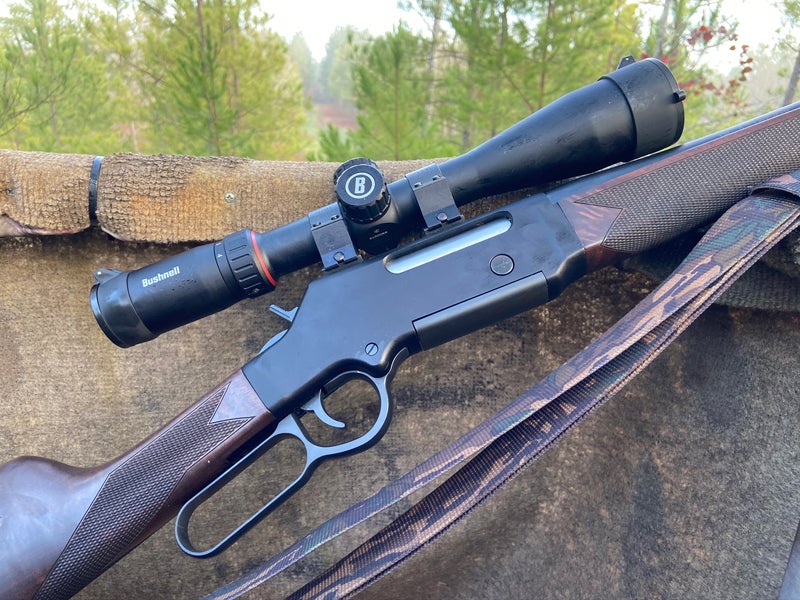
(Photo © Russ Chastain)
At the site of the hit I found quite a lot of light-colored hair, but no blood. I knew where she’d been standing and her tracks were clearly visible, but she’d entered thick brush immediately; tracking would not be easy without a blood trail. I began wishing I had a good dog handy.
I eased into the woods, taking the most obvious route. Although more than one deer had run this way, I could only assume the biggest tracks were from the biggest of them — the one I’d shot.
Seven minutes after finding the hair, I spotted some dark red blood!
As I eased along, I tried not to fret about the scarcity of blood. This was far from my first rodeo, but we are all human and subject to doubts. I slowly picked and poked my way through the brush, finding the occasional spot of blood and marking them with bits of paper towel.
After a while, the blood increased. I really liked that, and then I looked ahead and through the heavy brush I glimpsed my deer lying nice and still. It had seemed like a long time, but I spotted her just 14 minutes after finding the hair at the site of the hit.
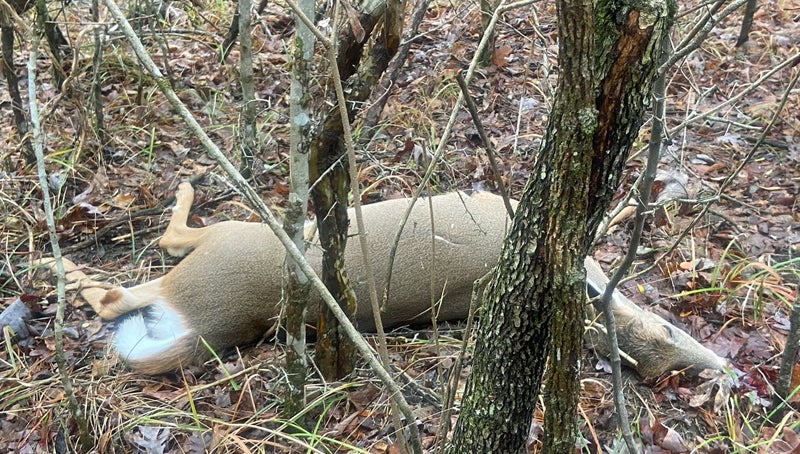
(Photo © Russ Chastain)
It had been a perfect double-lung shot, with the Nosler bullet knocking a considerable hole in the near ribcage before passing through the lungs and breaking the offside shoulder. Even so, the deer had traveled 75-80 yards before expiring.
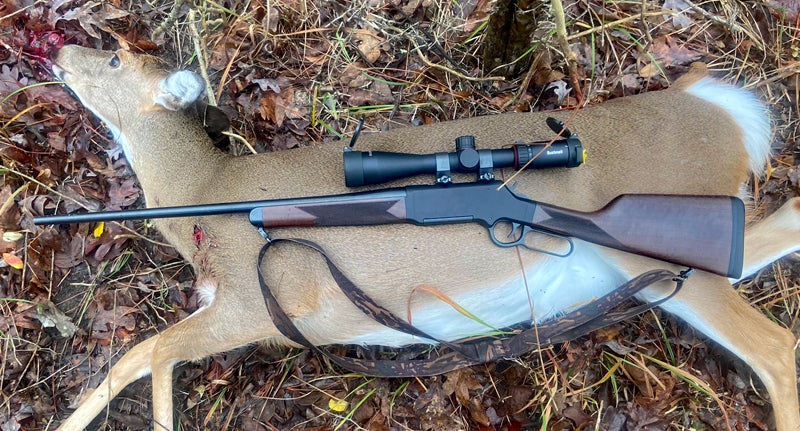
(Photo © Russ Chastain)
The doe weighed in at 120 pounds and was about 6.5 years old — and absolutely loaded with fat. Thank goodness the summer-long drought finally broke.
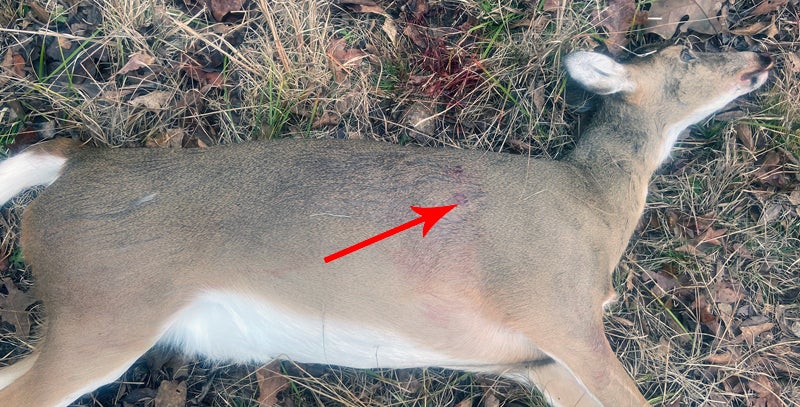
(Photo © Russ Chastain)
Needless to say, I was happy with the Henry. What’s not to like? Likewise, the Bushnell Nitro 4x-16x had allowed me to ID a bunch of different deer during the hunt. If I had to complain about the scope at all, it would be something that also plagues many more-expensive scopes; namely that in low light at high magnification, the scope just doesn’t gather as much light as I’d wish it to. But I’ve gotten equal or worse performance from scopes for which I’ve paid a lot more money (I’m currently seeing this scope priced below $300).
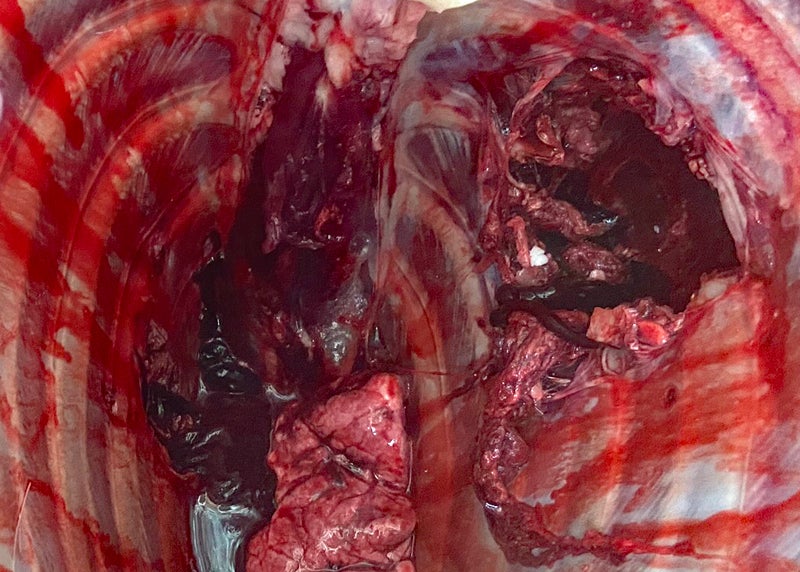
(Photo © Russ Chastain)
I saw nothing during the evening hunt, and the next morning showed me zero deer, but it did bring me another kill.
I’d been sitting in a stand seeing a whole lot of nothing, when I finally spotted movement ahead. A fairly low-slung animal was moving along the dirt road I was watching. I quickly popped the flip-up Bushnell scope caps & scoped it and was excited to see a large coyote sauntering towards me with its head held low, out in front of its body.
“Oh please God, oh please,” I muttered as I freed my right fingers from my glomitt so they’d fit through the Long Ranger’s lever loop and thumbed the hammer back, quickly settled into a firm shooting position, steadied the Multi-X reticle on the canine’s face, and let ‘er rip.
If you’ve read about my 2019 muzzleloader hunt, you will know why I wanted that coyote; a couple months earlier a deer I’d shot had been devoured by coyotes before I could recover it. And I always say I’d shoot a coyote even if it was standing next to a buck, because coyotes do a lot of damage to native game populations and you just don’t get that many chances at them.
This coyote took the Federal-loaded Nosler Accubond bullet in the face — the right eye, to be exact. It fell over and that was it… the critter never even twitched.
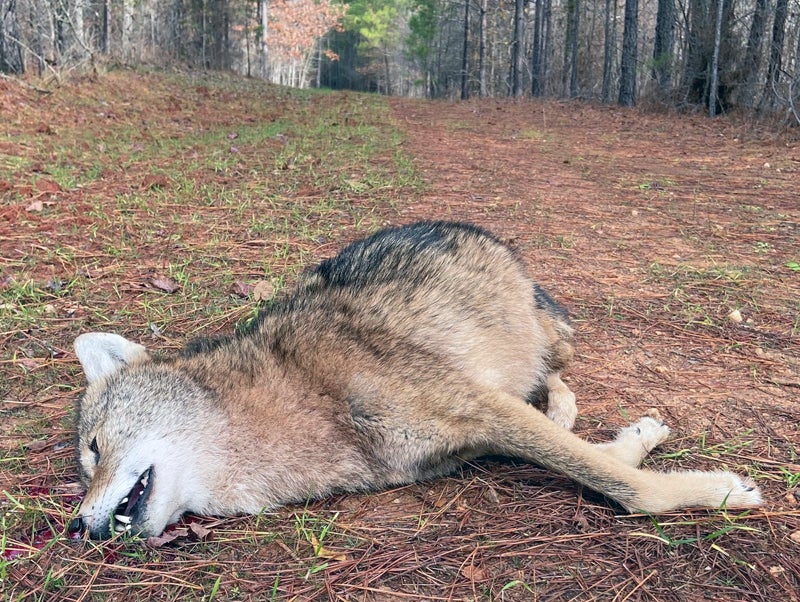
(Photo © Russ Chastain)
The range was 135 yards.
I continued to hunt with the Henry, but got no more opportunities on that trip. Was it a good one? You bet!
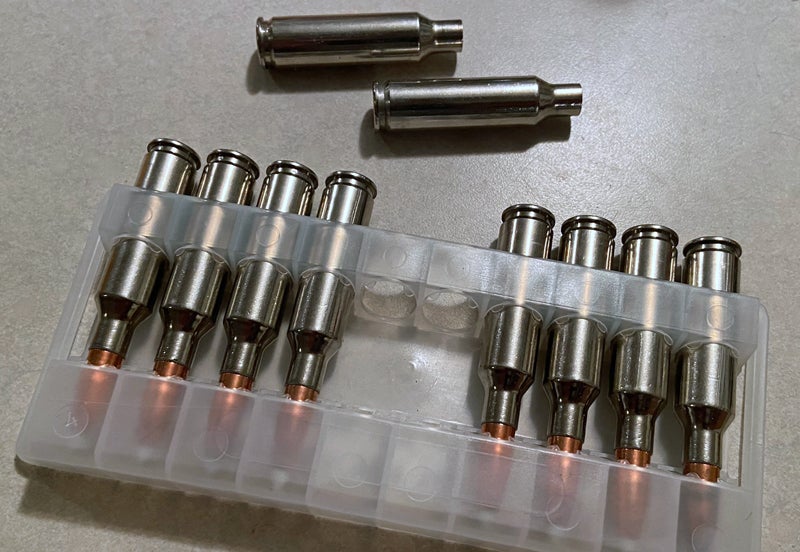
(Photo © Russ Chastain)
Keep your eyes peeled for reviews of this rifle and scope, but as you can tell from this story, both of them provided me with more good than bad. I can highly recommend this ammo as well.
Happy hunting.